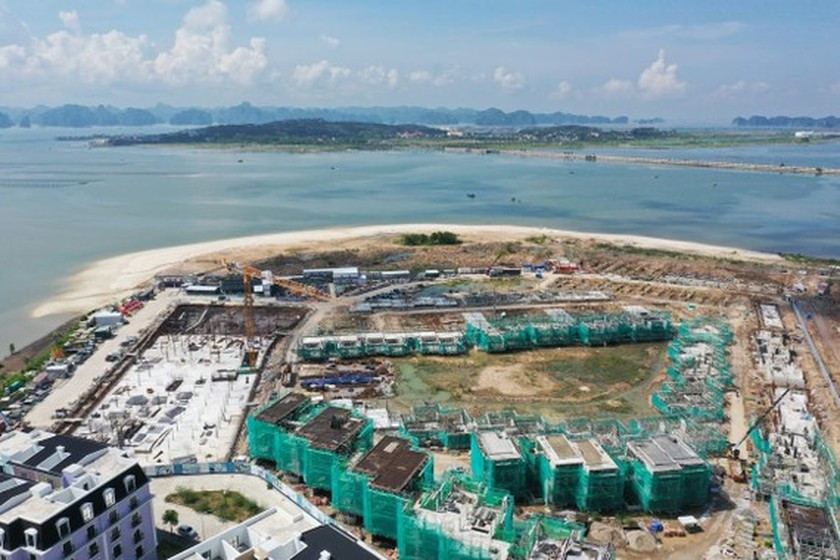
However, it also resulted in the rise of concern about the environment.
Not only the 100-ha Ao Tien high-class tourism urban area project in Van Don District but also many similar projects, even some located right in the Ha Long Bay area, which has been recognized by UNESCO as a World Natural Heritage, have been a cause for concern because they are allowed to conduct sea encroachment.
Among the projects to encroach on the sea in Quang Ninh Province, Tuan Chau Tourist and Entertainment Area is one of the earliest projects implemented since 1997 with an initial scale of 300 hectares; after many times of adjustments, the master plan has expanded to about 1,000 ha. Around Tuan Chau pier are rows of adjacent houses, shophouses, and luxury hotels of the Tuan Chau Marina Urban Area project.
Although this area has been invested in construction, synchronous planning of technical and social infrastructure is very luxurious, but it is very deserted. Even, a series of adjacent houses, and shophouses are still empty and covered with mossy next to luxuriant lawns while many other apartments have signs for sale or rent.
Meanwhile, for the construction of Tuan Chau Marina Urban Area, the project owner filled land, rocks, mud, and sand into Ha Long Bay to encroach on hundreds of hectares of water surface by filling in the shape of flower petals that are gradually reaching out and to complete the project since 2017.
Just a few kilometers from Tuan Chau is the Ha Long Marina Urban Area the project, also known as Hung Thang Urban Area in Ha Long City with a scale of 248 hectares which is divided into three peninsulas.
From 2013 up to now, the project investor has built and put into operation a number of component projects, such as apartments, San Ho adjacent townhouse, and commercial and entertainment complex Ha Long Marina Plaza.
Such projects are all formed from land encroaching on Ha Long Bay. Among them is the Horizon Bay Ha Long project with a scale of over 10 hectares with hundreds of 6-story high-rise villas and 3-story villas which are advertised to have a good view of the heritage bay.
At Horizon Bay Ha Long, adjacent rows of houses and infrastructure have been completed synchronously but are still empty and quiet. Meanwhile, many local people said that in the past, Hung Thang was an island commune of Ha Long City. From 2000 to now, to serve the construction of Hung Thang urban area, people have cut mountains and hills to get soil and rocks to fill the sea for the 1.5km encroachment site into Ha Long Bay.
According to the Ministry of Natural Resources and Environment, by 2021, Quang Ninh Province is one of the localities with the most sea encroachment projects with more than 40 projects in an area of up to thousands of hectares, pushing up Quang Ninh Province’s economic condition. The province becomes one of the localities with the fastest socio-economic development in the country. Nevertheless, UNESCO has repeatedly issued warnings to Ha Long Bay about the environmental and landscape impacts due to sea encroachment, economic development, and tourism activities.
Recently, at the seminar on ‘Ha Long Bay World Natural Heritage Site Capacity and Sustainable Tourism Development Management’, Chief Representative of UNESCO in Vietnam Christian Manhart pointed out that it is high time local authorities and responsible sectors had to have a strategy for the preservation and promotion of the value of Ha Long Bay's heritage; at the same time need to exploit it harmoniously. Similarly, many environmental experts also expressed concern about a series of sea encroachment projects surrounding and encroaching on Ha Long Bay and Bai Tu Long Bay.
Director of Human Geography under the Vietnam Academy of Social Sciences Nguyen Song Tung said that sea encroachment has been becoming a trend for urban areas and coastal areas, affirming the necessary development for the future.
However, in the past time, due to the lack of good requirements for planning and environmental impact assessment, a number of projects with sea encroachment activities have badly affected the landscape, environment, and ecological systems, causing coastal erosion. Not only that, many reclamation areas are located in coastal wetlands, with high biodiversity and great value for marine ecosystems; hence, the filling of these wetlands with rocks and soil leads to serious ecological degradation.
Moreover, many projects encroaching on the sea to build hotels, resorts, amusement parks, and apartment buildings have destroyed and polluted the marine ecosystems and the marine environment.
In particular, after the sea encroachment project comes into operation, these areas are often used for economic development purposes; thereby, generating more and more waste and polluting the environment. As a result, without careful planning, this will be great pressure on the marine environment.
Source: SGGP